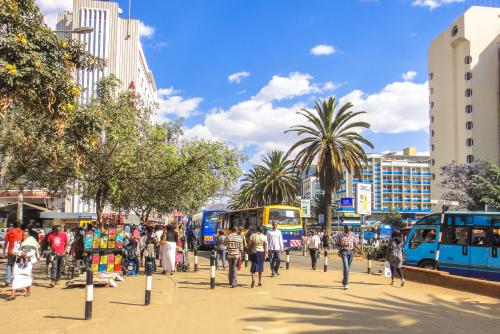Below is a viewpoint from the Foresight Africa 2023 report, which explores top priorities for the region in the coming year. Read the full chapter on Africa’s cities.
 Structural transformation involves the movement of workers from low-productivity sectors to high-productivity sectors. It has historically been associated with a shift from agrarian economies to more industrial economies based around urban areas, as seen in many Western nations as well as the Southeast Asian giants. For these economies, it is thought to have been crucial to economic growth and poverty reduction, by creating jobs and improving labor productivity.
Structural transformation involves the movement of workers from low-productivity sectors to high-productivity sectors. It has historically been associated with a shift from agrarian economies to more industrial economies based around urban areas, as seen in many Western nations as well as the Southeast Asian giants. For these economies, it is thought to have been crucial to economic growth and poverty reduction, by creating jobs and improving labor productivity.
In many African countries, however, the prospect of a thriving manufacturing industry seems difficult to realize. Urbanization has taken place without structural transformation with the share of employment in manufacturing in sub-Saharan Africa far below South Asia, even though South Asia has a lower urbanization rate than sub-Saharan Africa (Figure 45). Further, African cities’ economic sectors are dominated by low-productivity, informal enterprises, most of which are found in the services sector—specifically wholesale and retail trade, while a few enterprises are engaged in informal manufacturing. Large segments of Africa’s urban population work in the low-paid, informal wage economy, often self-employed.
Disentangling the connections between Africa’s cities and the slow pace of structural change will be essential for creating growth and reducing poverty, as structural transformation has the potential to foster economic diversification and inclusive growth. For effective policymaking, it is important to understand the drivers of structural transformation at the city level. It is also crucial to understand what alternative patterns of structural transformation–that is, leapfrog development (economic transition from agriculture to services, jumping the manufacturing stage)–might mean for the sustainable growth of African cities.
Urbanization has taken place without structural transformation with the share of employment in manufacturing in sub-Saharan Africa far below South Asia, even though South Asia has a lower urbanization rate.
For example, the economic landscape in Greater Accra, the capital of Ghana, provides a picture of this experience. At the sub-city level in Accra city region, economic activities are dominated by the services sector largely made up of informal enterprises. The share of manufacturing establishments and employment are very low compared to services (Figure 46). Productivity at the city region is generally low, but it is not homogenous across the different areas of the city. This leapfrog development (from agriculture to services) has not resulted in the creation of productive jobs in the city.
Moreover, the organizational type (private limited) and formality and institutional performance of city governments seem to correlate with low productivity of enterprises. Some of the major constraints to enhancing productivity and economic transformation in the city include access to long-term finance, high cost of production especially for energy, land, transportation, and space for business operations, higher costs for public services due to bureaucratic tendencies by city officials, and excessive influence of political leadership and interference at the sub-city level. City governments would need greater capacities, resources, and support to improve the performance and productivity of enterprises—particularly the establishment of new manufacturing enterprises in the city. Further, there is room to transfer some of their services to the private sector, work together with relevant institutions to carry out appropriate land reforms, and seek investments in critical infrastructure that would help the growth of high-productivity enterprises. Given the rapid increase in the size of African cities, as more workers move to urban areas from rural areas in search for jobs, urbanization must be accompanied by structural transformation in Africa. Consequently, policies that foster productivity growth among formal and informal enterprises, as well as deliver productive jobs for Africa’s urban workforce will be critical to the success of the continent in economic development in the years ahead.
The Brookings Institution is committed to quality, independence, and impact.
We are supported by a diverse array of funders. In line with our values and policies, each Brookings publication represents the sole views of its author(s).










Commentary
How can cities create better jobs in sub-Saharan Africa?
February 28, 2023